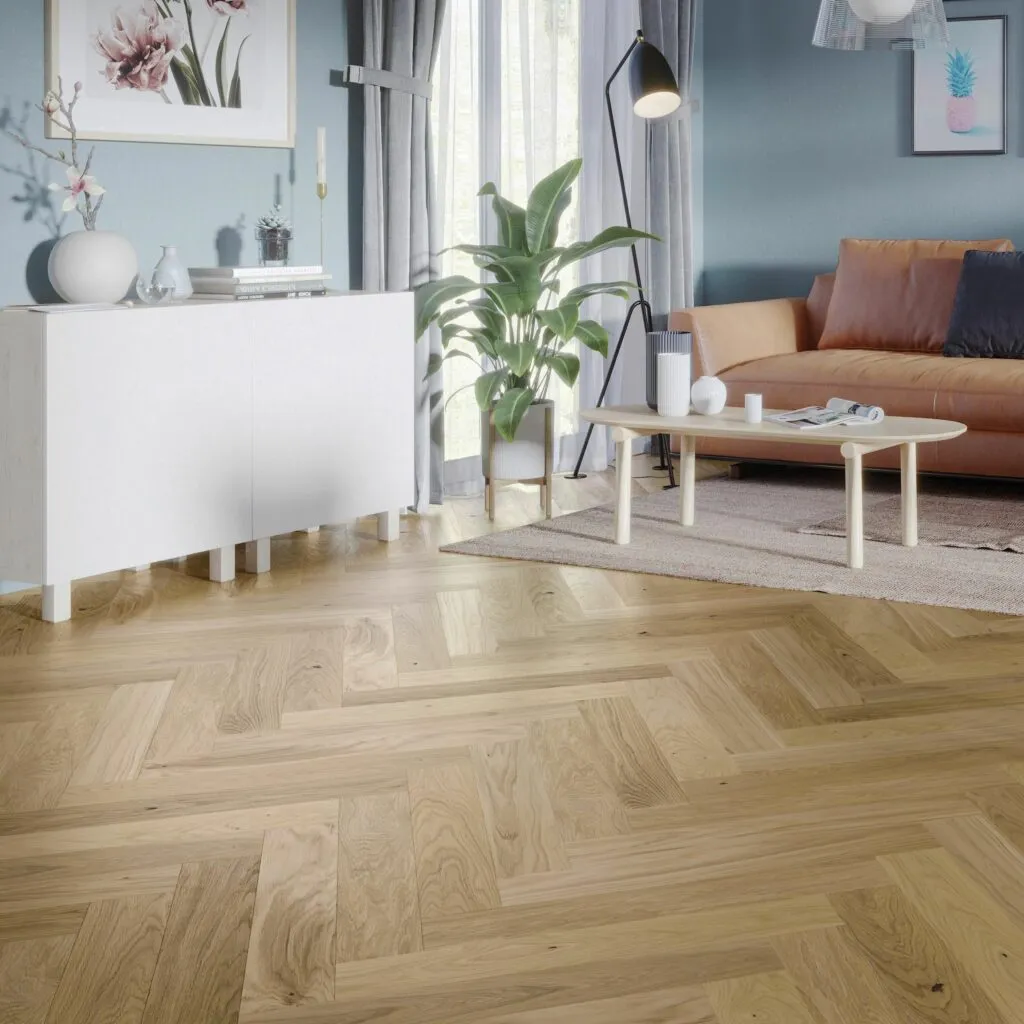So you’ve decided on engineered wood flooring? Great choice! Now for the installation process. Here at Tile Mountain, we want to make sure that your engineered wood flooring is beautiful and functional, so we’ve made a handy guide to get you started on your newest DIY project.
Tools & Materials Required:
- Engineered wood flooring
- Hand saw
- Wooden mallet
- Claw hammer
- Moisture detector
- Tape measure
- Pencil
- Trimming knife
- Set square
- Spacers
- Tapping block
- Pulling bar
- Underlay
- Duct tape
Step 1: Preparing Your Floor
Before you start to roll out your underlay, you’ll want to ensure that the area you’re working on is properly prepared.
Vacuum the area to remove any debris, ensuring that it is clean and dust-free and removing any screws that might be poking out of the surface.
Make sure that the area that you’re working on meets the humidity requirements advised by the engineered wood flooring manufacturer’s instructions using the moisture detector.
Finally, place your spirit level around all areas of your floor to check to see that it’s as level as possible with no more than 3mm height variation over 1m in length.
The underlay will only cover minor imperfections, so ensure that your subfloor is as level as it can be.
Step 2: Underlay
When your engineered wood flooring is delivered, make sure that it is laid flat on the ground and not up against a wall because of the risk of it bending.
Leave it in the room where it is going to be installed for at least 48 hours before installation.
The direction of the underlay is quite important as you will want to have your boards perpendicular, going the opposite direction.
Make sure that you are purchasing the correct type of underlay so that it is suitable for the flooring you are using.
There is a large selection of underlay to choose from, the most common being:
- 2mm clear underlay (no protective membrane)
- 2mm silver underlay (protective membrane)
- 3mm gold underlay (protective membrane)
A protective membrane will provide a barrier to stop moisture from getting through to the flooring.
Always make sure the colour side of your underlay is facing down towards the ground.
Starting in one corner of the room, place the underlay flush up against the skirting board and roll it out until it meets the other side.
Use scissors or a trimming knife to remove the excess underlay and tape off the edges for a temporary hold.
Line the edge of the second piece up to the first one, ensuring that they do not overlap.
Continue this process until you reach the last part of the room.
Make sure that the last piece of the underlay is pressed up tightly against the skirting board, trim it down to size and then run a continuous piece of tape where the two edges meet.

2mm Clear Underlay | 2mm Silver Underlay | 3mm Gold Underlay
Step 3: Laying Your Planks
When laying the flooring, open up at least 3 boxes of wooden planks and keep taking one from out of a different box each time, as you might find that there are only slight variations between the planks in the same box.
When working from side to side laying the planks, bear in mind that the last plank, closest to the wall, must comply with the amount per the manufacturer’s recommendations.
Additionally, when you get to the end of the room, the width of the last row must exceed the amount per the manufacturer’s recommendations.
Start with the first plank in the corner of the room and work from there, with each offcut piece at the end of the room being transferred to the start of the next row.
Make sure to place the spacers around the edges of the room, to ensure that there is the recommended expansion gap between the walls and the flooring – this is to ensure that the flooring is not damaged by changes in the temperature of the room.
To cut the planks, you can turn them upside down and press them up against the wall across the gap.
Allow the last plank to sail over the existing panel that’s fitted into place and mark the last plank on the back, side and across the front for where you would need to cut, leaving space for the expansion gap.
The planks are easy to cut using a hand saw, however, an electric saw will make the job a lot faster.
Use a tapping block to fit the planks together and a pulling bar when you reach the edges.
Once you’ve finished laying your first 2 – 3 rows, repeat the process, making sure that you’re staggering each joint by around 500 mm
Ensure that the final cut and the beginning of each row exceeds 500mm whilst also maintaining a 10 mm gap around the edges.

Espina Classic Oak Engineered Flooring | Tile Mountain
Step 4: The Final Row
Take a measurement of the width of the gap and mark on the last planks where they will need to be cut.
When cut, these will fit together just like the last pieces, however, you may need a pulling bar to fit them into place.
Lastly, remove all the spacers around the edges and cover the expansion gap with a scotia bead.
